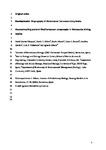Reconstructing ancient Mediterranean crossroads in Deronectes diving beetles
| dc.contributor.author | García-Vázquez, D | |
| dc.contributor.author | Bilton, David | |
| dc.contributor.author | Alonso, R | |
| dc.contributor.author | Benetti, CJ | |
| dc.contributor.author | Garrido, J | |
| dc.contributor.author | Valladares, LF | |
| dc.contributor.author | Ribera, I | |
| dc.date.accessioned | 2016-10-03T08:26:01Z | |
| dc.date.issued | 2016-08-01 | |
| dc.identifier.issn | 0305-0270 | |
| dc.identifier.issn | 1365-2699 | |
| dc.identifier.uri | http://hdl.handle.net/10026.1/5535 | |
| dc.description.abstract |
<jats:title>Abstract</jats:title><jats:sec><jats:title>Aim</jats:title><jats:p>To reconstruct the evolutionary history of a genus of freshwater beetle with a pan‐Mediterranean distribution, to test classic hypotheses which proposed a Miocene origin for groups with high biodiversity in the Iberian and Anatolian peninsulas.</jats:p></jats:sec><jats:sec><jats:title>Location</jats:title><jats:p>Mediterranean basin.</jats:p></jats:sec><jats:sec><jats:title>Methods</jats:title><jats:p>We sequenced four mitochondrial and one nuclear gene from 51 specimens of 30 of the <jats:italic>c</jats:italic>. 60 extant species of <jats:italic>Deronectes</jats:italic> (Dytiscidae), all typical of mid‐mountain streams from North Africa and Iberia over most of Europe to the Middle East. We used maximum likelihood, Bayesian probabilities with an <jats:italic>a priori</jats:italic> evolutionary rate and a dispersal–extinction–cladogenesis model to reconstruct their biogeographical history.</jats:p></jats:sec><jats:sec><jats:title>Results</jats:title><jats:p><jats:italic>Deronectes</jats:italic> has two major lineages which originated in the mid Miocene; one including mostly eastern and another mainly western and central Mediterranean species. From these two areas, range expansions, mainly at the end of the Miocene and beginning of the Pliocene, resulted in the many species groups and some of the extant species of the genus. Most of the current diversity and distributions are, however, of Plio‐Pleistocene origin, particularly in widespread European species.</jats:p></jats:sec><jats:sec><jats:title>Main conclusions</jats:title><jats:p>In line with traditional hypotheses, we found an ancient division between eastern and western Mediterranean lineages of <jats:italic>Deronectes</jats:italic>, likely resulting from the isolation of Europe west of the Alps from the Balkans and Anatolia during the early‐middle Miocene. The history of the genus was strongly influenced by major geological and climatic events, with successive cycles of fragmentation and subsequent eastward and westward range expansions, resulting in a steady accumulation of species across the basin. Most of these range movements took place through the north side of the Mediterranean, with only local displacements in the south during the Messinian salinity crisis and a recent (Pleistocene) colonization of the Italian Peninsula, which remained largely submerged through most of the genus’ evolutionary history.</jats:p></jats:sec> | |
| dc.format.extent | 1533-1545 | |
| dc.format.medium | Undetermined | |
| dc.language | en | |
| dc.language.iso | en | |
| dc.publisher | Wiley | |
| dc.subject | biodiversity hotspot | |
| dc.subject | dispersal | |
| dc.subject | diversification | |
| dc.subject | Dytiscidae | |
| dc.subject | Mediterranean | |
| dc.subject | Messinian salinity crisis | |
| dc.subject | phylogeny | |
| dc.title | Reconstructing ancient Mediterranean crossroads in Deronectes diving beetles | |
| dc.type | journal-article | |
| dc.type | Journal Article | |
| plymouth.author-url | https://www.webofscience.com/api/gateway?GWVersion=2&SrcApp=PARTNER_APP&SrcAuth=LinksAMR&KeyUT=WOS:000380056900005&DestLinkType=FullRecord&DestApp=ALL_WOS&UsrCustomerID=11bb513d99f797142bcfeffcc58ea008 | |
| plymouth.issue | 8 | |
| plymouth.volume | 43 | |
| plymouth.publication-status | Published | |
| plymouth.journal | Journal of Biogeography | |
| dc.identifier.doi | 10.1111/jbi.12740 | |
| plymouth.organisational-group | /Plymouth | |
| plymouth.organisational-group | /Plymouth/Faculty of Science and Engineering | |
| plymouth.organisational-group | /Plymouth/Faculty of Science and Engineering/School of Biological and Marine Sciences | |
| plymouth.organisational-group | /Plymouth/REF 2021 Researchers by UoA | |
| plymouth.organisational-group | /Plymouth/REF 2021 Researchers by UoA/UoA07 Earth Systems and Environmental Sciences | |
| plymouth.organisational-group | /Plymouth/Research Groups | |
| plymouth.organisational-group | /Plymouth/Research Groups/Marine Institute | |
| plymouth.organisational-group | /Plymouth/Users by role | |
| plymouth.organisational-group | /Plymouth/Users by role/Academics | |
| dcterms.dateAccepted | 2016-01-01 | |
| dc.rights.embargodate | 2017-3-11 | |
| dc.identifier.eissn | 1365-2699 | |
| dc.rights.embargoperiod | 12 months | |
| rioxxterms.versionofrecord | 10.1111/jbi.12740 | |
| rioxxterms.licenseref.uri | http://www.rioxx.net/licenses/under-embargo-all-rights-reserved | |
| rioxxterms.licenseref.startdate | 2016-08-01 | |
| rioxxterms.type | Journal Article/Review |


